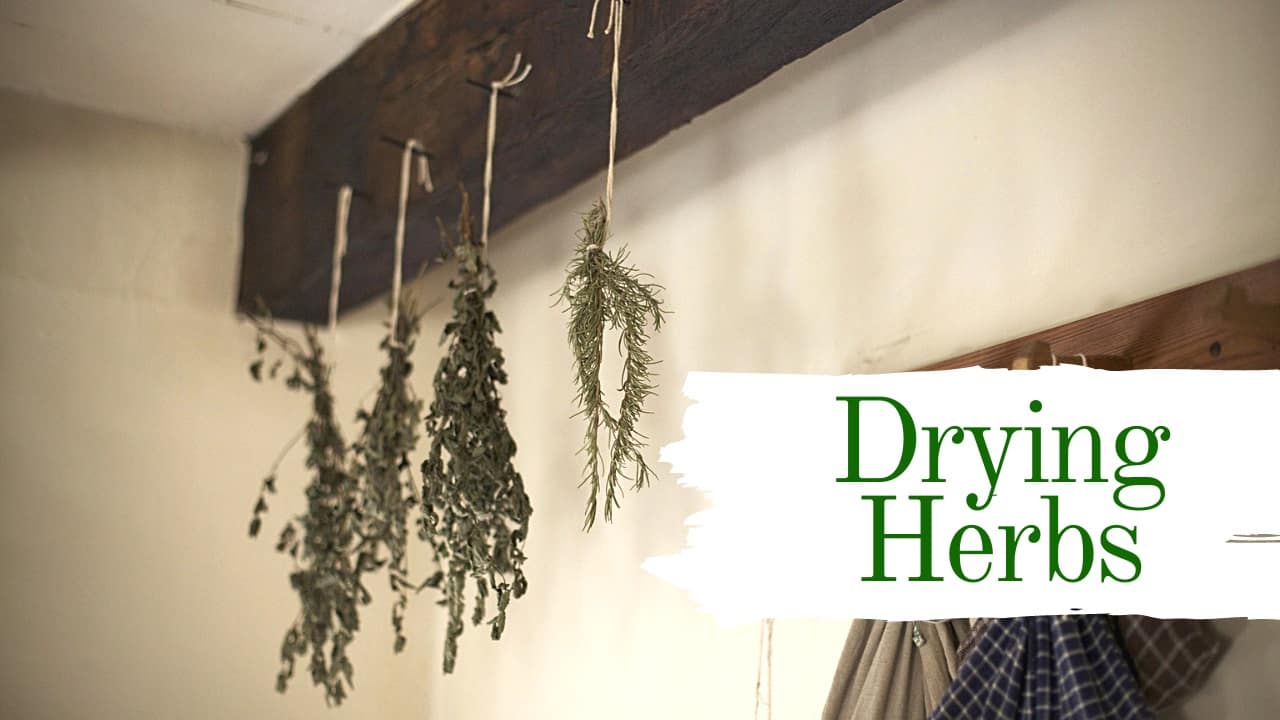Drying herbs at home is a great way to preserve fresh herbs so they don’t go to waste. Luckily herbs are very easy to dry, and they will last for a long time in storage. So, next time you have excess herbs don’t throw them away instead, you can try one of the easy herb drying methods in this article.
Herb Drying Methods
The simplest way to dry herbs is to tie them up into a bunch and hang them upside down in a dry part of your house like a closet, attic, or even outside in the sun. This method works well in most cases, but if your harvesting and drying herbs frequently it can be a little slow. If you want to dry your herbs faster here are some quick and easy ways to dry herbs at home:
Herb Drying Rack
Herb Drying Racks (Buy Online) are an old fashioned way to quickly dry herbs at home. They dry herbs much faster than hanging them in bunches since they allow for greater airflow around the herbs. The added circulation and faster drying time will also prevent the herbs from growing unhealthy fungi and mold.
Herb Drying Racks are still limited by the moisture in the surrounding air. If you live in a humid climate then an herb drying rack might not be the best option for you. Instead, you might want to try drying herbs in the microwave or drying herbs in a dehydrator.
Drying Herbs in the Microwave
Believe it or not, you can actually dry herbs in your microwave and it’s easy to do! First, you want to pick the leaves from the stems and only save the parts you want to use. Then you can lightly rinse the leaves to remove any unwanted debris.
Once the leaves are dry you can place them in the microwave between two paper towels and zap them for about a minute. Then open the microwave and check if the leaves are dry if they need more time keep microwaving them for 30-second intervals until they are done.
Drying Herbs in a Dehydrator
A Food Dehydrator (Buy Online) is one of the best ways to dry herbs in bulk, especially if you have a dehydrator with multiple shelves. You also want to use a dehydrator that has fine mesh shelves to keep the leaves from falling through the racks as they dry,
Make sure you clean the herbs and throw any damaged herbs away before placing them in the food dehydrator. Then lay the herbs flat on each tray and try to space them evenly.
Set the dehydrator on its lowest setting and let the herbs dry for about four hours. Then remove the dried herbs from the dehydrator. The herbs might be stuck to the shelves, so you might need to carefully break them off the fine metal mesh. It’s a good idea to do this over a bowl to catch as much of the dried herbs as possible.
Drying Herbs in Oven
If you don’t have a dehydrator to dry herbs with then you can use your oven. You can lay the herbs on a pan with a layer of muslin or cheesecloth to keep the herbs from getting stuck to the pan. You can also dry herbs on a silicone mat if you don’t have muslin or cheesecloth.
Set your oven on the lowest setting and let the herbs dry for about 30 minutes. They will be ready once the leaves are dry and are easy to crumble. Just make sure you remove them promptly once they are done since they will burn if you bake them for too long.
How To Store Dried Herbs
You can use an Airtight Glass Canister (Buy Online) to store dried herbs, which is much better than the ones you get at the grocery store,. This is the best way to keep herbs fresh and preserve their flavor. There are also vacuum-sealed containers that you can use for long term storage.
If you don’t want to get a special herb storage container you can use jelly jars or an airtight plastic container like Tupperware. You can even store herbs in oil if you want to make your own herb-infused oils.
What Herbs Can You Dry

So, now that you know how to dry herbs at home you probably want to know what herbs you can dry in the first place. Large leafy herbs like basil, sage, cilantro, and rosemary are very easy to dry and they require very little preparation. While herbs like tarragon, thyme, and dill have smaller leaves that might require more effort to remove the leaves from the stem.
The good news is that you can dry almost any herb you want. Just make sure that you remember which herb your drying since they all tend to look the same once they shrivel up.
Some herbs will lose a little bit of their flavor when they are dried, so some people still prefer fresh herbs over dried herbs. But dried herbs deliver lots of flavors, and you can crush them up into a fine powder that helps release their essential oils.
What To Do with Dried Herbs
Herbs & Spices: (Buy Online) is a great book that will guide you through the wonderful world of cooking with herbs. It has recipes that cover a wide spectrum of cooking styles and cuisines from all over the world. It also covers a wide range of rare herbs that aren’t commonly used in western culture. If you’re interested in what to do with herbs this book definitely covers it all.












